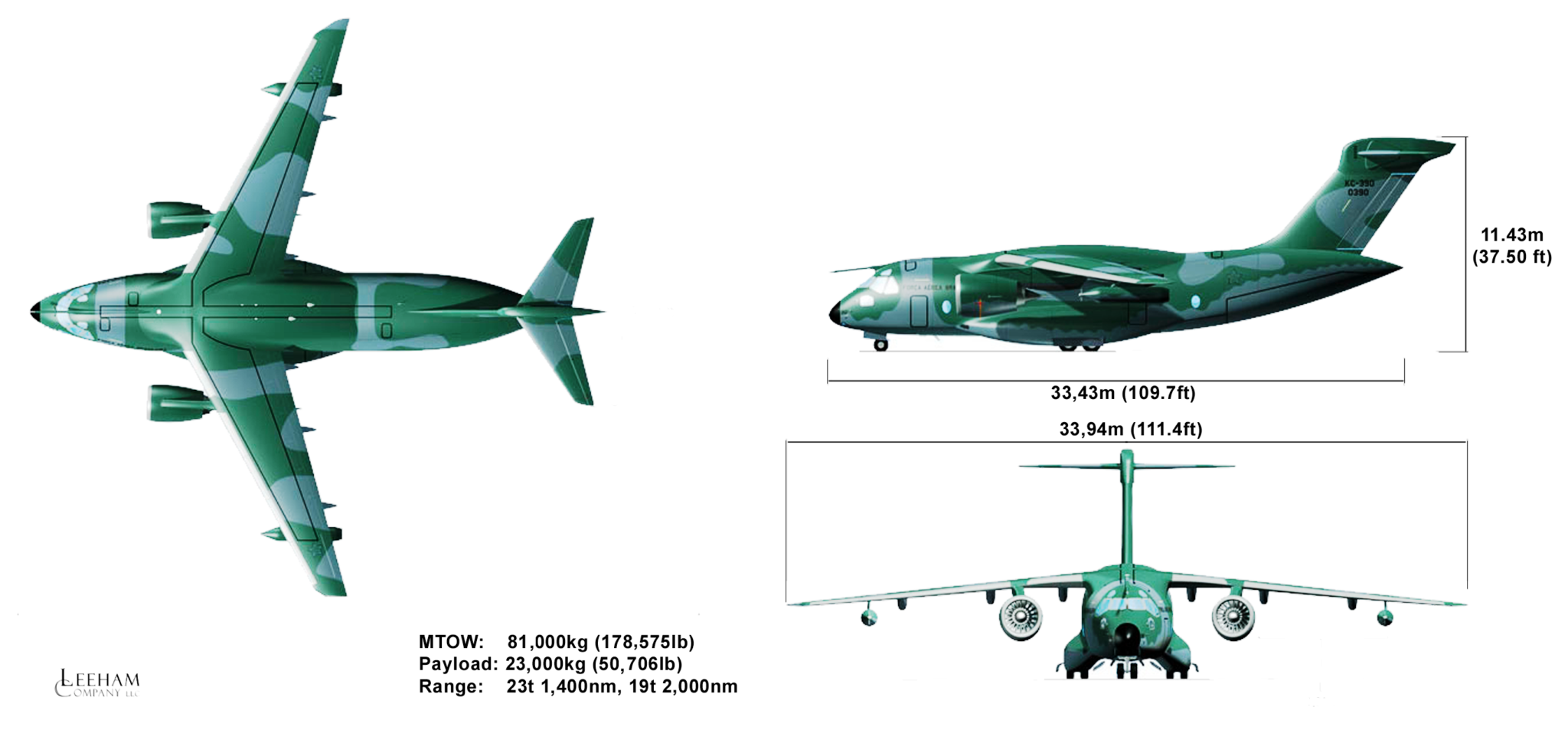Leeham News and Analysis
There's more to real news than a news release.
Embraer’s big bet on its largest airplane yet
Introduction
Embraer is days away from the roll-out of its biggest airplane project yet and one that has the potential to make its biggest inroads yet into the global defense market: the KC-390.
The airplane, with a fuselage cross-section the size of the Boeing 767, challenges the Lockheed Martin C-130, a venerable aircraft that has been updated throughout the decades since it first entered service in 1956. Despite this modernization, Embraer believes the time has come for a modern design and a multi-mission capability that far surpasses that of the C-130, with higher productivity of a jet aircraft vs a four-engine turbo-prop.
Summary
- Embraer sees a market for 728 KC-390s in 77 countries, excluding the US, Russia, China and Europe.
- The KC-390 is half the price of the Airbus A400M and about the size of the Lockheed Martin C-130.
- Launched with paid development and an order for 28 aircraft from Brazil to fulfill the country’s unique requirements.
- Typical mission capabilities will be: Cargo 7 pallets, Displacement of 80 soldiers, air dropping of 86 paratroopers, transporting 1 Black Hawk helicopter or one LAV25 or 3 Humvees, Rescue missions, Air tanking of 2 aircraft or helicopters.
- The KC-390 flies at M0.8 and will therefore finish missions in two thirds the time of the C-130 Hercules (which flies as M0.5). This will also result in more missions flown per day i.e. more airlift capacity.
Odds and Ends: 737 rate hike on cash flow; How the Chicago ATC fire impact unfolded; New PW engine chief
737 rate on on cash flow: The Seattle Times has a good article that described the impact on cash flow the decision by Boeing made to boost 737 production to 52/mo in 2018. The rate hike comes at a time when we believe production rates on the 777 Classic will be bottoming out to perhaps as low as five per month, which of course will negatively affect cash flow at Boeing.
We expect Boeing to further increase production rates of the 737 in 2019. The 777X production will just be in its infancy, with entry-into-service planned for 2020. (Information continues below the picture.)

Later this month, we will unveil a new, updated Leeham News and Comment with a combination of paid and free content. Watch this space for more information.
The decline in production rate of the 777 Classic, which we think will happen in 2017 and a like rate reduction for the 747-8, which we believe will occur as early as 2016, represents the reason why Wall Street analysts are turning more and more bearish on Boeing stock.
Odds and Ends: Comparing Airbus, Boeing 20-year forecasts; A320neo first flight; 787 battery probe fizzles; Mythbusting
Airbus v Boeing forecasts: The Blog by Javier takes its annual look at and comparison of the Airbus and Boeing 20-year forecasts. Airbus issued its new forecast this week; Boeing’s annual update was issued last summer.
Separately, the A320neo with Pratt & Whitney engines made its first flight today. The CFM LEAP neo is supposed to follow by six months. Showing class, Boeing Tweeted a congratulations for a milestone for the industry.
787 battery probe: The US National Transportation Safety Board hasn’t been able to find the root cause of the lithium ion battery failure in the Japan Air Lines and ANA Boeing 787 incidents. Now, the Japanese investigation has also failed to find the root cause of the ANA battery meltdown.
It’s rare but not unknown for investigators to not find root causes of problems, sometimes for years. A Northwest Airlines Boeing 747-400 split rudder hard over during a flight from Anchorage to Tokyo is one example; it took four years to determine the cause. The root cause of Boeing 737 rudder hard-overs, two of which caused fatal accidents, went unsolved for years.
Boarding airplanes: The reality show Mythbusters, an often entertaining look at myths, conventional wisdom, fact and fiction, takes a deep dive into airplane boarding. The article, with an insert to the episode, is here.
The Southwest Airlines style of boarding, with no seat assignments and derisively called cattle-call boarding, is the fastest and the most annoying, according to Mythbusters. Back-to-front is the longest. The Window-Middle-Aisle works best (but for those of us who like the aisle seat, the overhead bins are usually stuffed by then).
ISTAT Europe Conference in Istanbul: Boeing and Airbus slugging it out with some new twists
Airbus and Boeing squared off once again Monday, this time at the ISTAT Europe conference in Istanbul, once again pretty much over the entire product lines.
Boeing’s VP Marketing Randy Tinseth began with two focal points, the 737 with its latest developments and Boeing’s “superior” Twin Aisle line-up. Tinseth claimed Boeing has caught up to the A320neo with the 737 MAX.
After an A320neo head start of a year, Tinseth says Boeing has kept the same sales rate per year for the 737 MAX. The backlog of 737 MAX now stands at 2,300 aircraft and he described why Boeing thinks it is well positioned in this market segment.
Odds and Ends: KC-46A update; A440M in the US; A320neo first flight; Southwest no longer an LCC
KC-46A update: Aviation Week has an update on the status of the Boeing KC-46A tanker. Among other things, first fight has now been moved from June to November at the earliest.
A400M in the US: Airbus thinks it’s possible to sell hundreds of its A400M to the US Armed Forces to replace the Lockheed Martin C-130 and Boeing C-17, according to this article by Reuters.
A320neo first flight: Is the Airbus A320neo first flight going to run behind schedule? Airbus won’t say but Reuters suggests that it might. So does Aviation Week, like Reuters, pointing to an issue with the engine.
Southwest no longer an LCC: Bloomberg writes that Southwest Airlines is no longer a low cost carrier, with Cost per Available Seat Mile now approaching the legacy carriers. Years ago we characterized Southwest as the first legacy LCC, as costs increased, low fares began to disappear (it’s often easier to find a low fare on a competitor today) and routes took it into big city airports previously eschewed.
Odds and Ends: Safran benefits from engine after-market; ExIm could back Airbus; Paine Field future
Engine After-market: Safran, which owns 50% of CFM International with GE Aviation owning the other half, is positioned in the “sweet spot” of the engine after-market, according to a recent report by Bernstein Research.
The report further supports our own analysis posted August 25 and the growing importance of MRO support in winning engine orders.
According to Bernstein, Safran “has the best positioning in the aircraft engine after-market” in the investment bank’s coverage. This position is “driven by two engine families with strong growth ahead and low exposure to older engines that are at risk of early retirement.”
Bernstein notes that more than 95% of Safran’s after-market sales are derived from the CFM56, which powers 75% of the narrow-bodied aircraft, and the GE90, which powers the Boeing 777-200LR/LRF and 777-300ER.
Future programs include the CFM LEAP, GEnx and GP7200. Past programs, in decline, are the first generation CFM56 and the CF6 on earlier wide-bodies.
ExIm and Airbus: In a statement surely to inflame those opposed to renew ExIm Bank authority, the president of the bank said it’s possible it could back funding of the Airbus A320 family built in Mobile (AL).
Paine Field future: It’s a little parochial but The Everett Herald has an article looking at the future of Paine Field, where Boeing’s wide-body airplanes are assembled. The article necessarily looks at the future of the Boeing 747, 767 and 777 Classic production.
Congress is now talking about a nine month extension of ExIm.
Odds and Ends: Boeing leads net orders YTD; A320neo; ExIm Bank; Frontier Air
Airbus vs Boeing orders: Airbus reported its order tally through August and while it surpassed 1,000 gross orders, it’s net orders trail Boeing significantly. This article sums things up nicely, though it doesn’t include Boeing’s last four days of August. Boeing reports weekly and the latest report is due out today. Through August 26, Boeing trails Airbus slightly in gross orders but leads in net orders.
Update: Boeing just posted its weekly order tally: 1,004 gross orders (to Airbus’ 1,001) and 941 net orders, still well ahead of Airbus’ net orders.
A320neo first flight: Airbus will launch the first flight of the A320neo this month for the airborne test program. This is powered by the Pratt & Whitney GTF; the CFM LEAP A320neo is supposed to follow by about six months. Entry-into-service for the GTF neo is planned for October 2015.
ExIm Bank: Members of Congress are looking at a short-term extension of the ExIm Bank‘s authority (read: until after the November election).
Frontier Airlines: This carrier is rapidly converting to an Ultra Low Cost Carrier business model, a process begun several years ago and accelerated last year. Aviation Week has an article that takes a look.
Go Seahawks: The NFL season opens tonight with the 2014 Superbowl champs Seattle Seahawks hosting the Green Bay Packers. Go Hawks!



